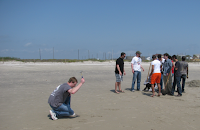It's not even been one year since the iPad hit the market and it is well on it's way to becoming an essential for many people around the world. According to CNN, the iPad has the fastest adoption rate of any consumer advice (read the full article here). I know that the iPad is difficult to put down, after standing in line all afternoon the day of the 3G release I was entertained the entire weekend.
But, what else can you do with the iPad. We've all seen the movies, games, and flashy organization apps in the adds, but what about more difficult work? The productivity category was initially slow to start, but now is full of options.
The numbers/pages/keynote set is $30 ($10 each) and has saved me several times. When I needed to make a promotion slide last minute at a conference keynote came to my rescue. I simply took images I needed from various emails and online, added some text, and in 10 minutes had a decent looking slide to submit. Numbers has allowed me to use some handy computational workbooks in the field to make very simple models of data that is coming in. Last, pages is very handy for quick edits on the road, or when out somewhere on campus. There are a few glitches, but they have continually be improving, especially in the area of importing Microsoft Office documents. So far, no track changes exists, but hopefully that will be coming soon.
For quick remote server administration I use iSSH. This is really a fantastic app with the exception that the arrow keys/command keys on the bluetooth keyboard don't work forcing you to use onscreen keys. This is the only limitation that prevents me from doing some full scale programming while connected to another machine back at home.
It's always important to know the weather while in the field and I use a combination of Storm Spotter and Radar Scope. The developer of Storm Spotter is another OU meteorology student and I highly recommend his app. Radar Scope does have a few things like spotter network, but it does not have any form of surface street map. Storm Spotter uses google maps which makes exact location or storm chasing much easier.
Another field essential is taking notes. There are many note apps out there and most do about the same things with different degrees of reliability. For quick sketches I use Penultimate and for class notes I use Note Taker HD, which has a 'zoom box' that lets me write large with my stylus (the Pogo Sketch) and it is normal sized writing on the page. Sundry notes is also around, but has not received any use by me for some time.
File sync is also an essential and can be done with Dropbox. I already loved this service and the mobile app made life easier! Now I can save notes from the field and they instantly sync to my computer at home, my phone, and my laptop.
For field math there is Wolfram alpha (cloud service), Quick Graph, and many apps like MathTasks that do simple calculations on the fly.
Sometimes I'll use a GPS utility to mark out rough locations on a map or even the iPad ArcGIS to get an approximate distance/area.
Finally, we all need files and file editing in the field. I use Papers to keep my scientific paper library with me at all times. In the field or at a conference it's easy to find that paper you need a snippet from and email it directly to the interested party/conference goer. Annotating PDF files is easy with iAnnotate PDF and viewing large files is nice with GoodReader (though Books now does this also).
While all these apps are productivity, you can bet all iPad owners have their favorite music service loaded, Netflix, and other entertainment too. While I do love using my iPad it does have overheating issues when working out in direct sun on a hot day. The screen is great at letting solar radiation in, and trapping the re-emitted IR inside the device, shutting it off in ~10 minutes. What can you do? Use a case with an open back and keep the screen shaded. I'm not quite ready to quit carrying paper notes all together, but it's getting close and my daily/travel backpack is getting lighter every year. Read about other great apps for large scale studies used in Pompeii here.
Images are property Apple.




















